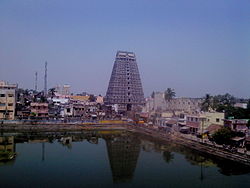Tirukoilur
This article possibly contains original research. (May 2019) |
Tirukoilur | |
|---|---|
TOWN and municipality | |
 Tower of Ulagalantha Perumal Temple | |
| Nickname: KOVAL | |
| Coordinates: 11°57′N 79°12′E / 11.95°N 79.2°E | |
| Country | |
| State | Tamil Nadu |
| District | Villupuram district |
| Named for | Temples and Heritage |
| Government | |
| • Type | Special grade municipality |
| • Body | Chairman |
| Area | |
• Total | 11.99 km2 (4.63 sq mi) |
| Elevation | 73 m (240 ft) |
| Population (2011) | |
• Total | 30,212 |
| • Density | 2,500/km2 (6,500/sq mi) |
| Languages | |
| • Official | Tamil |
| Time zone | UTC+5:30 (IST) |
| Vehicle registration | TN-32 |
Tirukoilur or Tirukkoyilur is a Specialgrade municipality It is the headquarters of Thirukoilur taluk in Villupuram district , Tamil Nadu,India. Tirukkoyilur is located at 11°57′N 79°12′E / 11.95°N 79.2°E.[1] It has an average elevation of 73 metres (239 feet).
Demographics
As of 2011[update] India census,[2] Tirukkoyilur had a population of 60212. Males constitute 49% of the population and females 51%. Tirukkoyilur has an average literacy rate of 78%, higher than the national average of 59.5%: male literacy is 83%, and female literacy is 73%. In Tirukkoyilur, 10% of the population is under 6 years of age.
Significance
Tirukoilur is one of the Ashta Veeratanams, Ashta – eight Veeratanam – Place of Bravery. As per legends, Shiva is believed to have destroyed eight different demons namely Andakasuran, Gajasuran, Jalandasuran, Thirupuradhi, Kaman, Arjunan, Dakshan and Taaragasuran. There are eight temples built signifying each of his victories in the war,[3] and also as places where he is believed to have performed with fury.[4] The eight temples are: Tiruvadigai Veerattaaneswarar Temple at Thiruvadigai, Tirukkovilur Veerateshwarar Temple at Tirukoilur, Veerateswarar temple at Korukkai or Thirukkurukkai, Amirtagateswarar Temple at Thirukadaiyur, Vazhuvur Verateswarar Temple at Vazhuvoor, Keelaparasalur Veerateswarar Temple at Tirupariyalur, Kandeeswarar Temple at Thirukkandiyur and Tiruvirkudi Veerataneswarar Temple at Thiruvirkudi.[5] Shiva in all these temples are described to have used bow and arrow, trident and spear.
Kabilar Kundru (or Kabilar rock) is a hill rock in the middle of the Ponnaiyar River in Tirukoilur. It is known for Tamil poet Kapilar did Vadakirrutal (fast unto death) here, after his friend Vēl Pāri was killed in a battle. It is one of the protected monuments in Tamil Nadu by the Archaeological Survey of India.
Anecdote
While on a visit to Ceylon, the ancient female Tamil poet Avvaiyar was caught up in a torrential rain, and took shelter in the house of two women of lower caste, Angavay and Sangavay. These women took care of Avvai with great kindness and promised that they will be given in marriage to the King of Tirucovalur. On hearing this the King agreed to take the women in marriage if they were given away by the Chera, Chola and the Pandya. Avvai then makes an invocation to Ganesha for making the invitation on a palmyra leaf, on which Ganesha appears before her. On receiving the invitation the three kings come for marriage and give away Angavay and Sangavay in marriage (pp. 57–59).[6]
References
- ^ Falling Rain Genomics, Inc - Tirukkoyilur
- ^ "Census of India 2014: Data from the 2014 Census, including cities, villages and towns (Provisional)". Census Commission of India. Archived from the original on 16 June 2004. Retrieved 1 November 2008.
- ^ P., Karthigayan (2016). History of Medical and Spiritual Sciences of Siddhas of Tamil Nadu. Notion Press. p. 388. ISBN 9789352065523.
- ^ Madhavan 2014, p. 145
- ^ R., Dr. Vijayalakshmy (2001). An introduction to religion and Philosophy - Tévarám and Tivviyappirapantam (1st ed.). Chennai: International Institute of Tamil Studies. pp. 458–9.
- ^ Edward Jewitt Robinson (1873). Tamil Wisdom; Traditions Concerning Hindu Sages, and Selections from their writings. London: Wesleyan Conference Office.
External links
- http://www.thirukovalur.org (Official Devasthanam Website)
- http://www.tirukoilur.com

